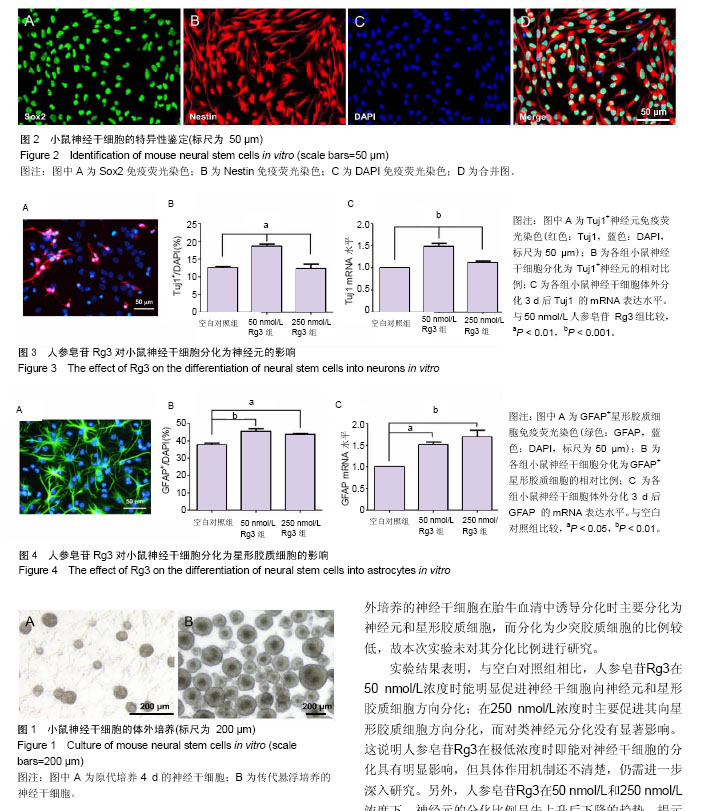| [1] Walker T, Huang J, Young K. Neural Stem and Progenitor Cells in Nervous System Function and Therapy. Stem Cells Int. 2016;2016:1890568.[2] English D, Sharma NK, Sharma K, et al. Neural stem cells-trends and advances. J Cell Biochem. 2013;114(4) :764-772. [3] 马浚宁,高俊玮,候博儒,等. 新生小鼠海马、嗅球及皮质神经干细胞的分离培养及鉴定[J].中国组织工程研究,2014,18(45):7266-7272.[4] Yamaguchi M, Seki T, Imayoshi I, et al. Neural stem cells and neuro/gliogenesis in the central nervous system: understanding the structural and functional plasticity of the developing, mature, and diseased brain. J Physiol Sci. 2016;66(3):197-206.[5] Vishwakarma SK, Bardia A, Tiwari SK, et al. Current concept in neural regeneration research: NSCs isolation, characterization and transplantation in various neurodegenerative diseases and stroke: A review. J Adv Res. 2014;5(3):277-294.[6] 石海杉,吴文,徐建兰.内源性神经干细胞的研究进展[J].实用医学杂志,2013,29(19):3252-3254.[7] Golmohammadi MG, Blackmore DG, Large B, et al. Comparative analysis of the frequency and distribution of stem and progenitor cells in the adult mouse brain. Stem Cells. 2008;26(4):979-987.[8] Maslov AY, Barone TA, Plunkett RJ, et al. Neural stem cell detection, characterization, and age-related changes in the subventricular zone of mice. J Neurosci.2004;24(7):1726-1733.[9] 方鑫,王芙蓉,姜亚平.影响神经干细胞定向分化因素的研究进展[J].临床神经病学杂志,2008,21(1):75-76.[10] 郑玉芹,姜正林,徐美玉. 人参皂苷Rb1对体外培养胎鼠神经干细胞增殖及分化的影响[J].神经解剖学杂志,2014,30(3):273-279.[11] 周志焕,王秀云,钟佩茹,等.人参皂苷Rg1对体外培养胚胎神经干细胞增殖作用的影响[J].中国中医药信息杂志,2010,17(2):28-30.[12] 廖丹琼,张建平,付银根,等. 人参皂苷Rg3对大鼠脑胶质瘤肿瘤干细胞增殖的影响[J].河南职工医学院学报,2011,23(2):131-133.[13] Kim HS, Lee EH, Ko SR, et al. Effects of ginsenosides Rg3 and Rh2 on the proliferation of prostate cancer cells. Arch Pharm Res. 2004;27(4):429-435.[14] 王兵,高勇,许青,等. 人参皂苷Rg3对肺癌诱导血管内皮细胞增殖的抑制作用[J].中国新药杂志,2002,11(9):700-702.[15] Huang L, Liu LF, Liu J,et al.Ginsenoside Rg1 protects against neurodegeneration by inducing neurite outgrowth in cultured hippocampal neurons.Neural Regen Res. 2016;11(2):319-325.[16] 郑友生,廖联明,江敏,等. 人参皂苷Rg1促进神经干细胞增殖的实验研究[J].世界中西医结合杂志,2011,6(12):1021-1024.[17] Clarke DL. Neural stem cells. Bone Marrow Transplant. 2003;32 Suppl 1:S13-17.[18] Reynolds BA, Tetzlaff W, Weiss S. A multipotent EGF-responsive striatal embryonic progenitor cell produces neurons and astrocytes. J Neurosci.1992;12(11):4565-4574.[19] 陈立铭,裴磊. 脑络欣通和左归丸药物血清体外培养神经干细胞的增殖和分化[J].中国组织工程研究,2016,20(32):4845-4851.[20] Ferrari D, Binda E, De Filippis L, et al. Isolation of neural stem cells from neural tissues using the neurosphere technique. Curr Protoc Stem Cell Biol. 2010;Chapter 2:Unit2D.6.[21] Xiong F, Gao H, Zhen Y, et al. Optimal time for passaging neurospheres based on primary neural stem cell cultures. Cytotechnology. 2011;63(6):621-631.[22] 刘吉星,候博儒,杨文桢,等. 神经干细胞体外培养鉴定及诱导分化的表型特征[J].中国组织工程研究,2015,19(19) :3054-3060.[23] 张涛,李文杰,王峰,等. 小鼠室管膜下区神经干细胞增殖及分化研究[J].干细胞与组织工程,2015,29(6) :766-771.[24] 白连琴,刘娜,李腾腾,等. 新生鼠和胎鼠海马神经干细胞分离和培养方法的比较[J].神经解剖学杂志,2015,31(4) :481-486.[25] 胡炜彦,于浩飞,张荣平. 人参皂苷Rg3对H2O2导致海马神经元损伤的保护作用研究[J].中成药, 2014,36(4) : 670-674.[26] 张建平,司银楚,朱培纯.人参皂苷Rg1诱导大鼠海马神经干细胞分化的实验研究[J].神经解剖学杂志,2009, 25(3):335-338.[27] 杨岚,张磊,李华. 人参皂苷Rg1对慢性应激大鼠海马神经发生的影响[J].现代预防医学,2015,42(10):1833-1835.[28] Sun ZG, Chen LP, Wang FW,et al.Protective effects of ginsenoside Rg1 against hydrogen peroxide-induced injury in human neuroblastoma cells.Neural Regen Res. 2016;11(7): 1159-1164..[29] Gonzalez-Perez O, Quiñones-Hinojosa A. Astrocytes as neural stem cells in the adult brain. J Stem Cells. 2012;7(3) :181-188.[30] Alvarez MI, Rivas L, Lacruz C, et al. Astroglial cell subtypes in the cerebella of normal adults, elderly adults, and patients with Alzheimer's disease: a histological and immunohistochemical comparison. Glia. 2015;63(2):287-312.[31] 陈玉敏,陈涛平. 星形胶质细胞的研究进展[J].现代中西医结合杂志,2008,17(28):4509-4510. |
.jpg)

.jpg)